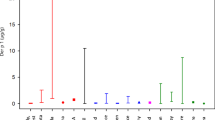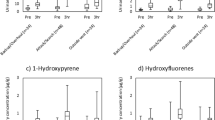Abstract
Charcoal cloth pads have been used to assess volatile chemicals on the skin in a laboratory setting; however, they have not yet been applied to measure dermal exposure in occupational settings. This study aimed at evaluating whether charcoal pads can be used to assess dermal exposure to benzene and toluene in workers of a petrochemical plant. Inhalation and dermal exposure levels to benzene and toluene were assessed for workers of a petrochemical plant performing different jobs. Benzene uptake was assessed by determining S-phenylmercapturic acid in workers' urine samples. Dermal exposure levels on the charcoal pads were adjusted for ambient air levels of benzene and toluene by subtracting the amount of benzene or toluene measured in personal air from the amount of benzene or toluene measured on the charcoal pad. In general, measured external and internal exposure levels were low. The estimated contribution of the dermal route to internal benzene exposure levels was less than 0.06% for all jobs. Toluene personal air concentrations and benzene and toluene dermal exposure levels differed statistically significantly between job titles. For benzene, differences between jobs were larger for adjusted dermal exposures (maximum 17-fold, P=0.02) than for inhalation exposures (maximum two-fold, P=0.08). Also for toluene, although less clear, differences between jobs were larger for adjusted dermal exposures (maximum 23-fold, P=0.01) as compared to inhalation exposures (maximum 10-fold, P=0.01). Charcoal pads appeared to measure dermal exposures to benzene and toluene in addition to ambient air levels. Future studies applying charcoal cloth pads for the dermal exposure assessment at workplaces with higher dermal exposure to organic solvents may provide more insight into the biological relevance of dermal exposure levels measured by charcoal cloth pads. In addition, the design of the dermal sampler might be improved by configuring a dermal sampler, where part of the sampler is protected against direct contact and splashes, but still permeable for the gas phase. This design would most likely result in a better ability to correct for airborne concentrations at a given body location.
This is a preview of subscription content, access via your institution
Access options
Subscribe to this journal
Receive 6 print issues and online access
$259.00 per year
only $43.17 per issue
Buy this article
- Purchase on Springer Link
- Instant access to full article PDF
Prices may be subject to local taxes which are calculated during checkout
Similar content being viewed by others
References
Boogaard P.J., and van Sittert N.J. Biological monitoring of exposure to benzene: a comparison between S-phenylmercapturic acid, trans, trans-muconic acid, and phenol. Occup Environ Med 1995: 52(9): 611–620.
Cohen B.S., and Popendorf W. A method for monitoring dermal exposure to volatile chemicals. Am Ind Hyg Assoc J 1989: 50(4): 216–223.
EPA. Toxicological Review of Benzene (Noncancer Effects). Integrated Risk Information System (IRIS), US Environmental Protection Agency, Washington, DC, 2002.
NIOSH. Hydrocarbon Aromatics: Method 1501. http://www.cdc.gov/niosh/nmam/nmammenu.html NIOSH Manual of Analytical Methods (NMAM®), 4th edn National Insitute of Occupational Safety and Health, 1994.
Roy A., Weisel C.P., Lioy P.J., and Georgopoulos P.G. A distributed parameter physiologically-based pharmacokinetic model for dermal and inhalation exposure to volatile organic compounds. Risk Anal 1996: 16(2): 147–160.
Van Sittert N.J., Boogaard P.J., and Beulink G.D. Application of the urinary S-phenylmercapturic acid test as a biomarker for low levels of exposure to benzene in industry. Br J Ind Med 1993: 50(5): 460–469.
Yu R., and Weisel C.P. Measurement of benzene in human breath associated with an environmental exposure. J Expos Anal Environ Epidemiol 1998: 6: 261–277.
Acknowledgements
We are grateful to the workers for participating in this study.
Author information
Authors and Affiliations
Corresponding author
Rights and permissions
About this article
Cite this article
van Wendel de Joode, B., Tielemans, E., Vermeulen, R. et al. Dermal exposure assessment to benzene and toluene using charcoal cloth pads. J Expo Sci Environ Epidemiol 15, 47–50 (2005). https://doi.org/10.1038/sj.jea.7500349
Received:
Accepted:
Published:
Issue Date:
DOI: https://doi.org/10.1038/sj.jea.7500349



